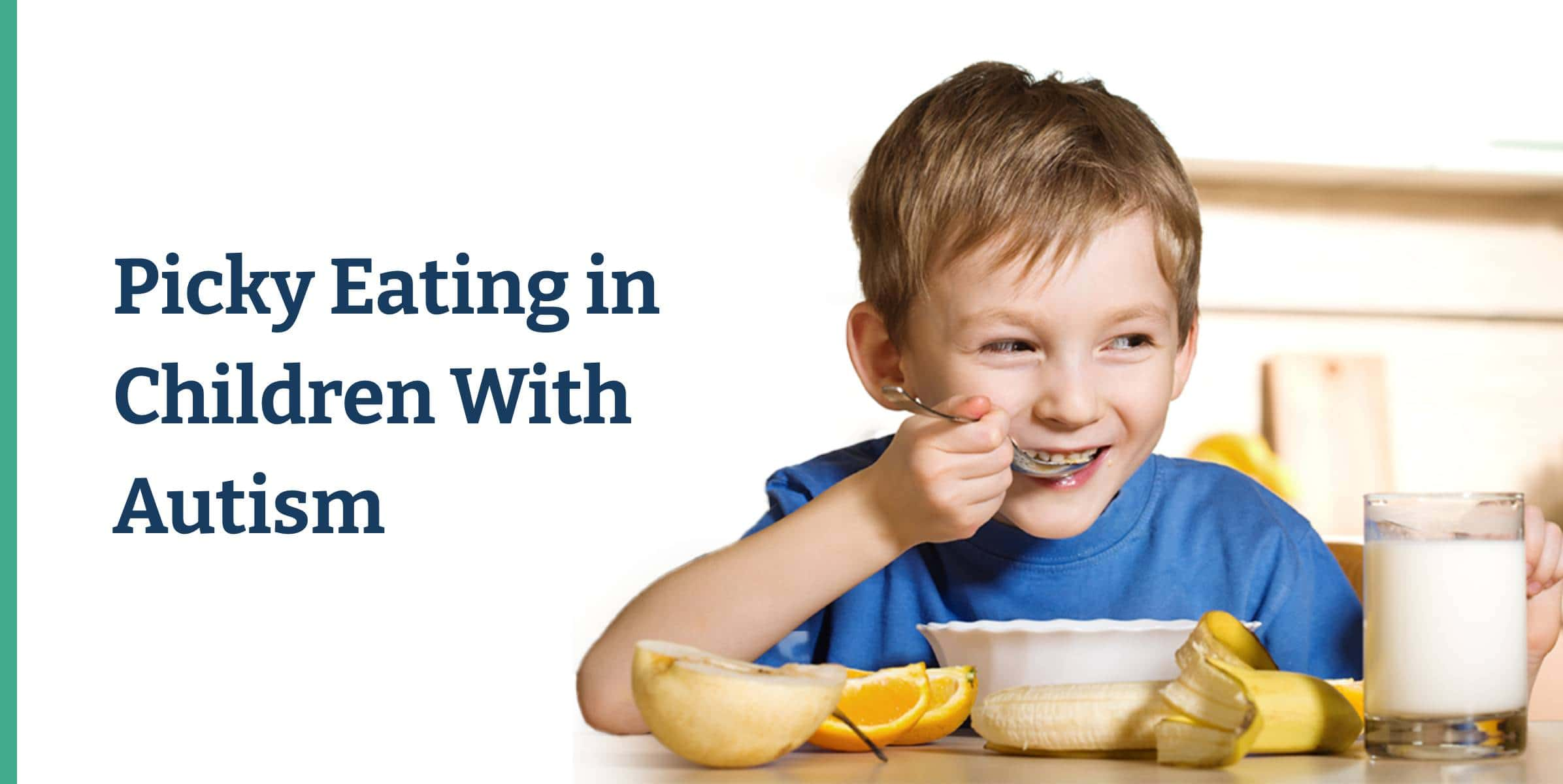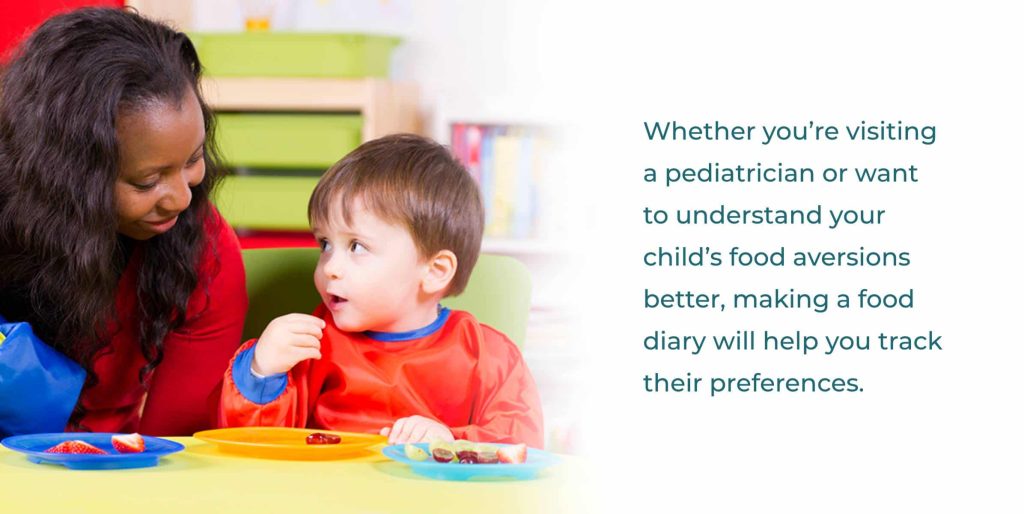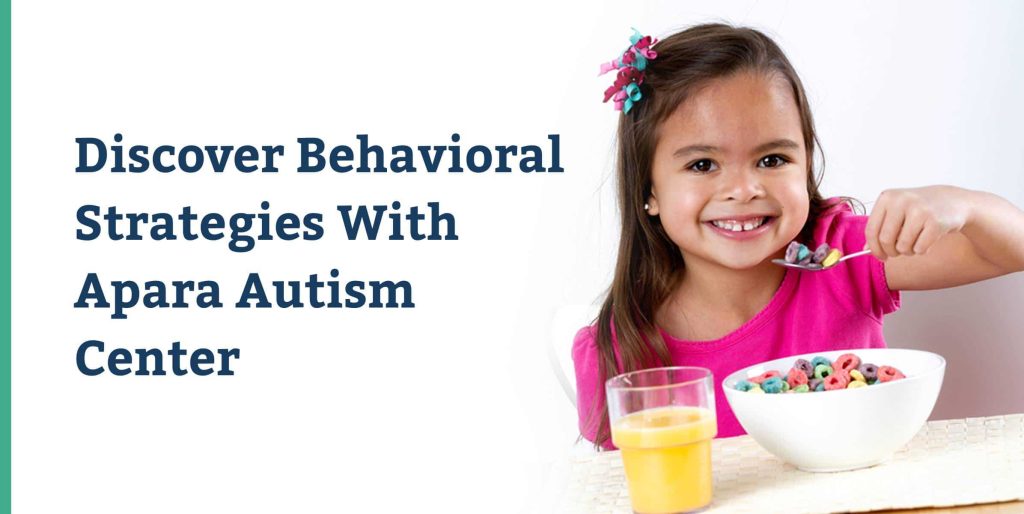Children diagnosed with autism spectrum disorder (ASD) often experience challenges with food selectivity, causing mealtime to become a difficult and stressful process. It’s estimated that 46%-89% of kids diagnosed with ASD have difficulties in their eating habits. Food selectivity, otherwise known as picky eating, can appear in children with ASD through rigid ritualistic eating habits, sensory issues around food, limited food preferences and tantrums around meals.
Understanding food aversions and implementing a safe and gradual approach can help them feel safer and more at ease during mealtime.
How Are Autism and Picky Eating Connected?
When finding a connection between your child’s autism and picky eating, it’s important to consider behavioral and medical factors, as autism and picky eating may go hand in hand in this scenario. Research suggests that autism can cause picky eating, commonly food avoidance and selection. Autism can affect eating habits in many ways, attributing to children rejecting certain foods or having issues with dinner table meals.
1. Sensory Issues
If your child shows extreme food aversions, picky eating could be associated with autism. Children with ASD often struggle with sensory issues, including hypersensitivity or under-sensitivity to any stimulation. Sensory issues can overwhelm a child or make eating an unpleasant, stressful experience.
Some food characteristics that have the potential to trigger sensory problems :
- Color
- Smell
- Shape
- Texture
- Temperature
- Organization
If a particular food, sensation, or setting causes sensory issues or stress, children may exhibit avoidant behaviors around that circumstance in the future. It is common for children with autism to develop a limited range of food preferences, often favoring specific textures or flavors while rejecting all others. For example, a child might only eat salty foods. They may also only eat room temperature food, refusing cold or hot meals. Watch your child’s habits to see if there’s a pattern behind their food preferences, as an understanding of the issue can be extremely helpful in determining which foods will be safe picks.
2. Gastrointestinal Problems
Children with autism may avoid certain foods due to gastrointestinal (GI) problems. Nearly 50% of children with ASD report GI symptoms such as constipation, trouble swallowing, diarrhea, vomiting, bloating, and abdominal pain, compared to 18% of children who don’t have ASD. GI discomfort can cause children to restrict their diets or engage in repetitive behaviors to avoid discomfort.
GI problems can come from limited diets or pre-existing issues that the child may struggle to identify or communicate, so taking your child to a pediatric gastroenterologist can help find potential causes and solutions for picky eating. If GI issues are causing food aversions, finding and treating these problems can help to alleviate eating discomfort and improve the child’s overall experience with food.
3. Pain
While GI problems can contribute to food aversions, other pain and irritation can also play a role in these behaviors. Particularly relevant for non-verbal children, any pain or irritation from eating food can lead to selective eating patterns. Allergies, unpleasant sensations, and general discomfort may have a child seeking out foods that avoid these issues as a solution. Many children, especially those who struggle with verbal communication, cannot locate or express pain and therefore resort to avoiding certain foods as a response.
Working with a pediatrician or allergist to test for potential food sensitivities can be very beneficial. Working a special diet into mealtime that avoids these foods can help alleviate stress and discomfort for the child. It is worth noting that some parents had success in lowering problems through gluten- or casein-free diets, however no current research supports these diets as effective treatments for autism. Therefore, it’s best to have a specialist identify an intolerance to prevent further health issues.
4. Restrictive Eating
Children with autism often show repetitive behaviors and have restrictive, narrow interests. This significantly limits their food choices making it a challenge to have them sit down and focus at the table. Trying new foods takes time and focus, which can be challenging for kids with ASD, especially if they have had negative experiences associated with trying new foods or simply eating at the table.
Common food-related issues that children with autism face include preference for specific brands, limited food preferences overall, and texture sensitivities. This can make trying new foods or consuming enough nutrients difficult for some children with ASD because they are restricting their food to only a particular brand or a few foods they find tolerable. Parents may also unintentionally reinforce selections by forcing children to eat food they’re opposed to or making them stay at the table too long.
Working With Food Aversion and Picky Eating in Autism
Navigating a child’s nutritional needs while accommodating to their food selections can come with challenges, but it’s essential to work with them and keep them as comfortable and stress-free as possible. Introducing foods too quickly, keeping them for too long, or forcing them to eat foods they are opposed to will prevent children from becoming more open to new selections.
Getting children with ASD to expand their food preferences takes careful planning and lots of time. Working toward comfortable compromises surrounding picky eating and autism must be done strategically, as negative experiences can lead to further reinforcement of negative views on food. Parents should expect progression to be slow and carefully schedule and organize each step along the way. You can use these strategies to help get children with autism comfortable with new foods.
1. Create a Food Diary
In order to have a deeper understanding of your child’s food aversions, whether for yourself or to prepare to meet with a pediatrician, making a food diary will help you track their preferences. Write out the foods children will eat, what they won’t eat, and their reactions to foods they dislike. Note if they have any physical irritations, rashes or GI issues after eating certain foods. Keep track of how long they’re comfortable sitting at the table and what situations can cause tantrums or distress. This may help to highlight the patterns to look out for, and to help better understand what attributes your child is comfortable with.
You should also write down your mealtime goals. Eventually, you’ll focus on achieving one goal at a time but first, start with laying out what you hope to achieve. Do you want them to eat more significant amounts of food? Do you want your child to eat more kinds of food? Do you want them to sit and eat with fewer or no disruptions? Set out the goals you want for your child’s eating habits to have a clear idea of what you’re working toward.
Keeping track of food, responses and other information will help you with antecedent, behavior and consequence (ABC) data for children with ASD. Collecting this information allows you to understand your child’s reactions and preferences better and helps you recognize patterns in their responses.
2. Rule out Medical Issues
See a pediatric gastroenterologist and potentially an allergist to rule out medical causes for food aversions. They might recommend diets that can help relieve discomfort or identify if a medical issue is causing pain for your child. Children will likely still avoid new foods to prevent negative sensations, but knowing if there’s an underlying problem that is contributing will help you start working towards expanding food options. In the realm of autism and picky eating, medical issues can be overlooked if parents and medical staff are too quick to assume that food aversion comes directly from ASD, failing to consider the rest of the situation medically.
3. Offer Children Choices
It’s important to let children feel in control over their food options. Give them choices to pick from for mealtime so some of the power around eating is in their hands. For example, offer them three different meats for protein options or three different types of fruit. Allowing them to make the food selection helps them feel in control. You could also make a meal and ask your child to pick one or two surprise foods or ingredients for everyone to try in their meal. Picky eating in autism, and in children in general, can sometimes be dealt with by allowing the child this modicum of control.
4. Make Food Fun
Get your child engaged with their food by playing around with it. Some studies show that children who participate in sensory play activities with their food are more likely to try that food after playing with it. Create pictures and faces with veggies or meal ingredients, use cookie cutters for fun food shapes and encourage playing with sauces. Have children get hands-on with their food — ask them for help preparing an easy, fun part of the meal — and let them see you taste and enjoy what you’re making.
5. Change Textures
With sensory issues being so common among children with autism, textures may prevent children from eating foods, even when they like the taste. When keeping track of your child’s food habits, identify the textures and flavors they prefer. Is there food they’ll eat that tastes similar to another food with a texture they dislike? Changing the texture of a food can make children more open to trying it. Chopping, blending and slicing foods into new textures can encourage variety.
Changing temperature can help with food exploration as well. Chilling or warming food to your child’s preferred temperature and dicing or blending may make it something tasty instead of gross. Experiment slowly and gently with new styles of serving food to encourage better eating habits.
6. Take It Slow
Getting children with ASD comfortable with new foods takes time. Pushing children too quickly can set you back or make them even more averse to some foods. Children with autism often have specific eating habits, so start slowly with choices and experimenting. Let them touch, lick, smell and mix the new food with old food. Only try one new food at a time. If they refuse a food over 10 times, they might not like it, so move on to something else.
Table behavior should also change slowly. If you’re working on improving eating behavior, only do that — don’t also include new foods. If your child hates sitting at the dinner table and likes eating in the kitchen or the living room, start by moving their chair a little closer to the dinner table. Also, don’t try to make children sit at the table for too long — over 20 or 30 minutes can cause stress and tantrums if they’re upset. Let them leave the meal when you see them becoming overwhelmed to avoid associating mealtime with negative emotions.
7. Be Predictable
Children with ASD are often frightened, distressed or anxious about unpredictable situations. Create a calm routine around mealtime to help them stay comfortable. Meals should happen on a consistent schedule so children always know what to expect. Having a schedule helps prevent anxiety caused by the unknown. Make sure to let children know what the plan is ahead of time and remove distractions so they can concentrate on this one scheduled activity.
8. Keep Calm
It’s essential to remain calm when trying to overcome food sensitivities. Exploring new food will take time, so be patient. Don’t get upset or try to force children to stay and eat. If mealtime turns into fights or a stressful, upsetting situation, children will likely become more food averse. Keep things light, fun and creative to encourage positive associations. Also, be sure to let your child see you enjoying food so they view it as a good, enjoyable thing.
9. Use Rewards Wisely
Pairing foods children prefer with a food they aren’t used to yet can be a smart way to encourage explorative eating. Offering treats or rewards for testing out new food is a good form of positive reinforcement and can help improve feelings around eating. Don’t use bribes or rewards too often, though. Too many rewards can prevent children from understanding why they should try new foods and eat better. You want to build understanding and curiosity with mealtime, so they eventually learn to accept more foods independently.
What Foods to Avoid With Autism
When working through picky eating and autism, keeping kids comfortable is essential. You should avoid foods that cause extremely unpleasant sensory experiences and only show children one new food at a time. If something around mealtime is upsetting for your child, work to reduce its presence and keep everyone calm. Avoid difficult-to-chew foods at first since many children with autism have motor difficulties and struggle to chew and swallow sometimes.
Avoiding dairy, gluten and casein is common for parents of kids with ASD, but try to include these in your child’s diet to improve their nutrition. If a pediatrician recommends diets without specific food groups, you should follow them as directed.
Stay away from foods high in sugar or processed ingredients. Food selectivity can cause nutritional deficiencies, and processed foods may only encourage diet problems. Try to promote healthy alternatives like smoothies and soft fruits over sweet treats.
Food Ideas for Feeding a Picky Child With Autism
Creating a predictable routine and encouraging choices will help keep your child calm and comfortable. Post a food schedule in a place that’s easy for your child to access so they can see what’s coming during the week. While working with children on picky eating, try to incorporate supplements and probiotics into their diets to ensure they receive the proper nutrients.
1. Food-Chaining
Food-chaining is a popular technique for food introduction. The idea is to introduce food associated with your child’s preferences. If they like soft food in only one color, introduce them to yogurt, applesauce, pudding, soups and oatmeal. If they don’t like certain textures, slowly show them new forms of foods they like until they learn the taste is the same, even when the texture changes. For example, if they like red apples, have them try sliced red apples or maybe a green apple. Let them turn an apple into juice or applesauce and have them try it. Once they can expand their idea of apples, they can try them in different forms.
2. Play Games
Create games around food tasting along with providing choices. Use plates with activities printed on them or challenge children to brain games. Have them count food pieces, create word rhymes or make stories around the food. Getting them involved and interested will help them associate fun with food. Games can also help children with autism develop their motor skills and communication, necessary tools for navigating preschool and beyond.
3. Use Sauces or Seasoning
Some children love ketchup, peanut butter, ranch or barbecue sauce. Let them put their preferred dressing or sauces on foods in healthy amounts to encourage eating. If they can pair something they like with foods they aren’t sure of, children may try new foods more easily. Don’t let them use too much if it affects their nutrition negatively, but dipping sauces are fine in regular amounts, especially if they’re getting children to expand their food.
Discover Behavioral Strategies With Apara Autism Center
Working with food aversion can be stressful for families, caregivers and children, but it can improve with time and the right tools. Every child is unique, which is why Apara Autism Center offers personalized, comprehensive behavioral therapy programs to families of children with autism. Our applied behavioral analysis (ABA) therapy helps children develop foundational skills for building thriving, successful lives.
To accommodate your family’s individual needs, we offer telehealth, at-home and center-based therapy to help your children receive the professional services they need. Contact us today for a free consultation to learn more about providing your child with the best care.









